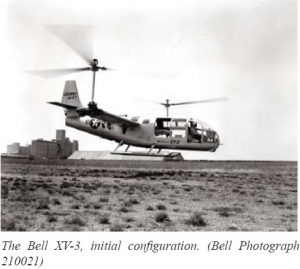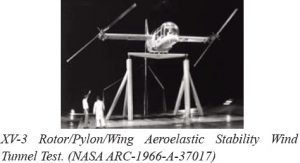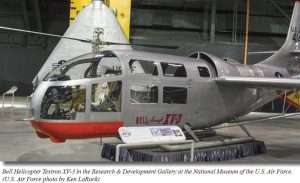by Martin Maisel (photos as credited)
Before the Transcendental Model 1-G tilt rotor demonstrator aircraft was destroyed, and prior to it accomplishing conversion the from helicopter mode to airplane forward flight, Bob Lichten, chief engineer of that project, had accepted an offer of employment from the Bell Helicopter Company. The offer was too good to refuse – Bell had offered Lichten access to the technological and financial resources of one of the world’s leading helicopter companies to further the development of the tilt rotor aircraft. Bell subsequently obtained the rights to Haviland Platt’s patent of the “Convertible Aircraft.”
 In 1953, under Lichten’s leadership, Bell won an Army- and Air Force-funded Convertible Aircraft Program contract to develop two demonstrator tilt rotor flight vehicles. The aircraft, designated the XV-3, began its flight test program in 1955 but experienced severe vibrations during partial conversion to the airplane mode.
In 1953, under Lichten’s leadership, Bell won an Army- and Air Force-funded Convertible Aircraft Program contract to develop two demonstrator tilt rotor flight vehicles. The aircraft, designated the XV-3, began its flight test program in 1955 but experienced severe vibrations during partial conversion to the airplane mode.
 During a test flight on October 25, 1956 the severe vibrations caused the pilot to lose control. The resulting crash destroyed the aircraft and seriously injured the pilot.
During a test flight on October 25, 1956 the severe vibrations caused the pilot to lose control. The resulting crash destroyed the aircraft and seriously injured the pilot.
An intensive analytical and experimental investigation was initiated by industry and Government researchers with the goal of understanding and resolving the unpredicted vibrations and airframe oscillations. The research revealed an aeroelastic instability that involved the rotor, the pylon (rotor support and shaft structure) and the wing. The rotor, when subjected to non-axial inflow at higher speeds, created large eccentric forces that deflected the pylon and wing. The
deflections grew until the elastic structure sprung back, starting the cycle over again. These deflections and oscillations could increase and become divergent with increasing airspeeds and could ultimately destroy the aircraft. (This aeroelastic phenomenon – sometimes referred to as a “whirl-mode instability” was also responsible for the in-flight losses of some early Lockheed L-188 Electra aircraft).
 Further research led to the development of new rotor designs and pylon/wing structures that were predicted to be aeroelastically stable well beyond the aircraft’s performance capabilities. After significant modifications, full conversion to the airplane mode was accomplished but the performance of the XV-3 was very poor.
Further research led to the development of new rotor designs and pylon/wing structures that were predicted to be aeroelastically stable well beyond the aircraft’s performance capabilities. After significant modifications, full conversion to the airplane mode was accomplished but the performance of the XV-3 was very poor.
A wind tunnel test of the modified XV-3 in the NASA Ames 40-by-80 foot wind tunnel verified the aeroelastic stability resolution. However, that aircraft was damaged during the test due to the failure of a transmission casing. The aircraft was eventually restored and is currently on display at the National Museum of the United States Air Force in Dayton, Ohio.
 While advocates continued to support the concept, the XV-3 did little to convince others of the value of the tilt rotor. The P&W Wasp Junior-powered XV-3’s hover performance was so poor that it could only lift one pilot (with no additional payload) and, in the airplane mode, could only fly at 115 knots level (155 knots in a dive) – when helicopters of the day could do much better.
While advocates continued to support the concept, the XV-3 did little to convince others of the value of the tilt rotor. The P&W Wasp Junior-powered XV-3’s hover performance was so poor that it could only lift one pilot (with no additional payload) and, in the airplane mode, could only fly at 115 knots level (155 knots in a dive) – when helicopters of the day could do much better.
Furthermore, the handling qualities were poor and flight operations were unduly complex (a gear-change device was used to reduce the rotor speed in the airplane mode to “improve” performance). Not even the advocates of the concept could consider the XV-3 an effective demonstrator of the capabilities of the tilt rotor
aircraft.
The XV-3 provided proof that the tilt rotor was a viable concept would be years away.

